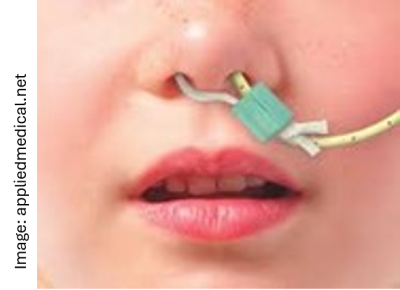Neurodiversity information for parents and young people
About nasal bridles
A nasal bridle is a length of ribbon gauze that is fitted with two small flexible probes, in the space behind the nasal septum (the structure in the middle of the nose). It is a safe and effective method of securing a nasal tube. Nasal tubes are commonly used for feeding or drainage of stomach contents.
The nasal bridle makes it less likely for a nasal tube to fall or be pulled out. This maximises the amount of time you receive nutrition and helps reduce the number of nasal tubes that need to be inserted.

How we insert your nasal bridle
A trained member of staff assesses you for the bridle and inserts it. The insertion usually takes place at your bedside.
Both insertion probes are lubricated to allow them to glide into your nasal passage. We insert one probe into each nostril. The probes are fitted with small magnets that ‘meet’ behind the septum.
One probe is connected to the ribbon gauze. We gently withdraw one of the probes; this allows the ribbon gauze to pass from one nostril, behind the septum through the other nostril. We then apply a clip to the nasal tube and the two ends of ribbon gauze.
If the nasal tube or bridle are pulled, this causes pain in your nose. This stops you pulling the tube or bridle accidentally or on purpose.
How we take care of your nasal bridle
While the nasal bridle is in place your nurse checks it regularly. They make sure the ribbon gauze and clip are secure, but not too tight or too loose. They inspect the skin around the nose to ensure it is not sore and confirm that the nasal tube remains in the correct place.
![]()
Tell your nurse if the nasal tube or bridle are uncomfortable or painful so they can be reviewed.
Risks of using a nasal bridle
- Injury to the septum is rare. We regularly monitor you and your nasal bridle. If there are any safety concerns, such as the nasal bridle pulling or causing tension on your septum, we will remove it immediately.
- Nose bleeds can sometimes happen when the nasal bridle is inserted (or shortly after). If this happens we monitor the bleeding closely and your nurse will inform your doctor.
- Any inflammation and/or irritation of the nasal passage, caused by the nasal bridle, is no greater than that caused by using a nasal tube.
- The nasal tube can be dislodged by being pulled through the bridle clip or ribbon gauze. Your nurse will check the position of your nasal tube regularly to ensure it is safe to use.

Tell your nurse immediately if you notice the tube has moved or been dislodged.
How we remove your nasal bridle
Removal of the nasal bridle is usually painless.
- When you no longer need the bridle and nasal tube, your nurse will remove them for you by cutting the ribbon gauze and sliding the nasal tube out.
- If the nasal tube needs to be replaced, we open the clip to allow removal and replacement of the tube.
- If the bridle is no longer needed we open the clip and glide the ribbon gauze out, leaving the nasal tube in place.
Contact information
Kingston Hospital Nutrition Nurses, Monday to Friday, 8.30am to 4.30pm